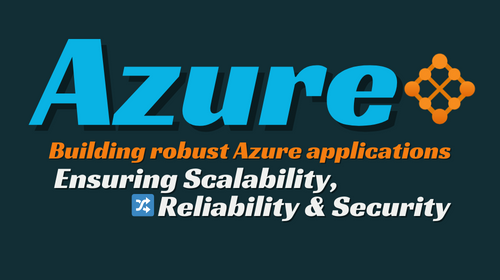- Home
- Migrations & Modernization
- 10 Essential Design Principles for Azure Applications 🔀
10 Essential Design Principles for Azure Applications 🔀
10 Essential Design Principles for Azure Applications: Building for Scalability, Resilience, and Efficiency
In the era of cloud computing, designing applications for platforms like Microsoft Azure requires a deep understanding of not just the technologies involved, but also the architectural principles that underpin scalable, resilient, and efficient systems. Whether you’re developing a small-scale application or a complex enterprise solution, adhering to well-established design principles can significantly enhance the performance, reliability, and maintainability of your Azure applications. Here are ten essential design principles to consider.
🔧 Design for Self-Healing: Microsoft emphasizes building applications resilient to failures by designing for self-healing. Utilize Azure’s built-in fault tolerance mechanisms, such as Azure Availability Zones and Azure App Service auto-healing features, to automatically recover from failures without human intervention.
🔁 Make All Things Redundant: Redundancy is key to avoiding single points of failure in Azure applications. Leverage Azure’s redundancy options, such as Azure Traffic Manager for traffic distribution across multiple regions, Azure Storage redundancy options, and Azure VM availability sets to ensure high availability and reliability.
🔗 Minimize Coordination: Microsoft advocates for minimizing coordination between application services to achieve scalability. Implement asynchronous communication patterns using Azure Service Bus or Azure Event Grid to decouple services and minimize dependencies, enabling horizontal scalability without performance bottlenecks.
⚖️ Design to Scale Out: Designing applications to scale horizontally is a fundamental principle in Azure architecture. Utilize Azure Kubernetes Service (AKS) or Azure Virtual Machine Scale Sets to dynamically add or remove instances based on demand, ensuring your application can handle increased workload without compromising performance.
🔀 Partition Around Limits: Microsoft recommends using partitioning to work around database, network, and compute limits. Utilize Azure Cosmos DB’s partitioning capabilities or sharding techniques to distribute data across multiple partitions, avoiding bottlenecks and maximizing scalability.
🛠️ Design for Operations: Designing for operations ensures the operations team has the tools they need to manage and maintain the application efficiently. Use Azure Monitor for comprehensive monitoring, Azure Automation for automated management tasks, and Azure Security Center for threat detection and response, empowering operations teams to effectively manage the application lifecycle.
☁️ Use Managed Services: Microsoft advocates for using platform-as-a-service (PaaS) offerings over infrastructure-as-a-service (IaaS) whenever possible. Utilize Azure PaaS services like Azure App Service, Azure SQL Database, and Azure Functions to offload infrastructure management tasks to Azure, allowing developers to focus on application logic and innovation.
🔑 Use an Identity Service: Leveraging an identity-as-a-service (IDaaS) platform enhances security and simplifies authentication and authorization processes. Utilize Azure Active Directory (Azure AD) for identity management, single sign-on (SSO), and multi-factor authentication (MFA), reducing the overhead of building and maintaining custom identity solutions.
🔄 Design for Evolution: Microsoft emphasizes designing applications for continuous evolution and innovation. Adopt agile development practices, utilize containerization with Azure Kubernetes Service (AKS) for flexibility and portability, and embrace DevOps principles to enable rapid iteration and deployment of new features and updates.
💼 Build for the Needs of Business: Every design decision should align with the business requirements and objectives. Prioritize features and functionalities that directly contribute to business value, leverage Azure’s analytics and AI capabilities to gain insights and drive informed decision-making, and continuously optimize the application to meet evolving business needs.

Components Used in above architecture
- Azure App Service is a fully managed platform for creating and deploying cloud applications. It lets you define a set of compute resources for a web app to run, deploy web apps, and configure deployment slots.
- Deployment slots lets you stage a deployment and then swap it with the production deployment. That way, you avoid deploying directly into production. See the release engineering and deployment section below for specific recommendations.
- IP address: The App Service app has a public IP address and a domain name. The domain name is a subdomain of
azurewebsites.net, such ascontoso.azurewebsites.net. - Azure DNS is a hosting service for DNS domains, providing name resolution using Microsoft Azure infrastructure. By hosting your domains in Azure, you can manage your DNS records using the same credentials, APIs, tools, and billing as your other Azure services. To use a custom domain name (such as
contoso.com), create DNS records that map the custom domain name to the IP address. For more information, see Configure a custom domain name in Azure App Service. - Azure SQL Database is a relational database-as-a-service in the cloud. SQL Database shares its code base with the Microsoft SQL Server database engine. Depending on your application requirements, you can also use Azure Database for MySQL or Azure Database for PostgreSQL. These alternatives are fully managed database services based on the open-source MySQL Server and Postgres database engines.
- Microsoft Entra ID is a cloud-based identity and access management service that lets employees access cloud apps developed for your organization.
- Azure Monitor is a solution for collecting, analyzing, and acting on logs and metrics across your environments.
- Azure Key Vault supports secrets management, key management, and certificate management. It can store application secrets like database connection strings.
By aligning with these Microsoft Azure design principles, you can build resilient, scalable, and efficient applications that leverage the full potential of the Azure platform to meet the demands of modern businesses and users.


Christopher
May 3, 2024Thank you For Sharing this